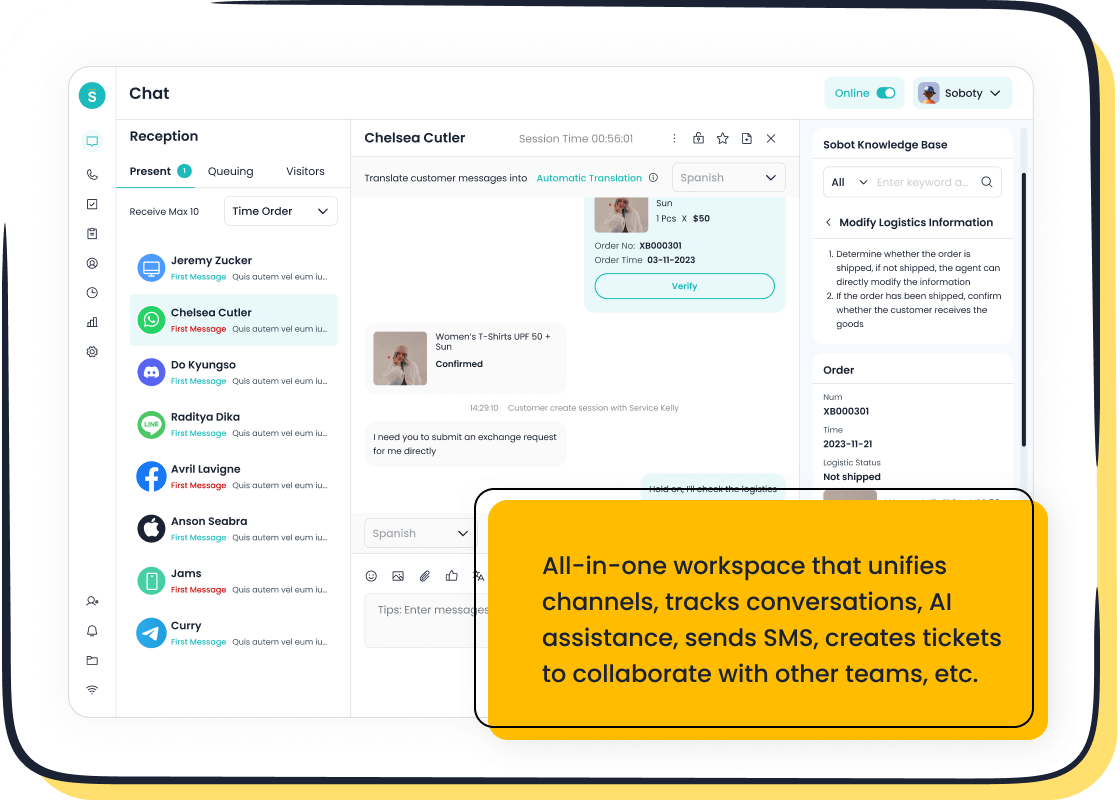Knowledge Management Zendesk vs Salesforce 2025

For businesses prioritizing ease of use for knowledge management for customer service, Zendesk is the better choice. For enterprises needing deep integration within a comprehensive CRM ecosystem, Salesforce offers more power. The knowledge management software market is projected to hit USD 22.9 billion in 2025. This growth highlights the importance of choosing the right customer service platform. The Zendesk vs Salesforce debate centers on balancing simplicity and power for customer support. A strong knowledge base is crucial for excellent customer service solutions. This comparison of Zendesk vs Salesforce will explore their knowledge management capabilities. Zendesk provides great support for many businesses. Salesforce delivers powerful support through its extensive CRM. Each platform helps manage customer knowledge effectively. For those seeking advanced solutions, consider how Sobot and Sobot AI can further enhance these capabilities, especially when integrated with a robust Sobot call center.
Zendesk vs. Salesforce: Knowledge Management at a Glance
| Feature | Zendesk | Salesforce | Winner |
|---|---|---|---|
| Ease of Use & Setup | High | Moderate | Zendesk |
| AI-Powered Search & Content Creation | Strong, user-focused | Powerful, data-intensive | Depends on need |
| Cost & ROI | Lower TCO, faster ROI | Higher investment, scalable for enterprise | Zendesk for SMBs |
| Integration with CRM | Excellent, with many apps | Native, seamless | Salesforce |
Cost and ROI Comparison

Evaluating the cost and return on investment is critical when choosing a knowledge management platform. The pricing models for Zendesk and Salesforce reflect their target audiences. Zendesk offers straightforward pricing that appeals to many businesses. Salesforce provides scalable pricing for large enterprises. A clear understanding of each platform's pricing helps a customer make the right choice for their support needs.
Total Cost of Ownership
Total Cost of Ownership (TCO) is a major differentiator between Zendesk and Salesforce. Zendesk is known for its budget-friendly approach. This makes Zendesk an ideal choice for startups and SMBs seeking powerful support tools without a large initial investment. The pricing plans for Zendesk are transparent. For example, a team of 50 customer support agents on the Zendesk Suite Enterprise plan might have an annual cost of around $101,400.
In contrast, Salesforce generally involves a higher TCO. The Salesforce pricing structure is designed for enterprises that require deep customization and integration. This higher pricing reflects the platform's extensive capabilities. While the initial cost for Salesforce is greater, its value comes from its scalability within a massive CRM ecosystem. The right customer for Salesforce sees this pricing as an investment in a long-term, integrated solution.
Implementation Speed and Time-to-Value
The time it takes to see a return on your investment often depends on implementation speed. Zendesk excels in this area. It provides a much shorter time-to-value. Many businesses can get Zendesk operational in days or weeks, not months.
For example, a typical Zendesk implementation can take between 5 to 9 weeks. Some companies, like Stanley Black and Decker, have launched a full omnichannel solution with Zendesk in just 3 weeks.
This rapid deployment allows teams to improve customer support quickly. Salesforce implementation is a more involved process. Its complexity and customization options require more resources and planning. This longer setup time is a trade-off for its powerful, tailored capabilities. For scaling enterprises, this investment can pay off significantly. A switch to Salesforce can lead to a 34% increase in customer service ROI, making the higher upfront cost and longer implementation a strategic decision for growth-focused organizations. Ultimately, Zendesk offers speed, while Salesforce offers depth.
Zendesk vs Salesforce: Core Feature Deep Dive
When comparing the core features of Zendesk vs Salesforce, a clear pattern emerges. A feature-by-feature analysis shows Salesforce supports more advanced functions, scoring 70% (27/30 features), while Zendesk scores 58.33% (24/30). This difference highlights their distinct philosophies. Salesforce offers a deep, powerful toolkit for enterprises that need extensive customization. Zendesk excels as a streamlined, out-of-the-box solution that prioritizes ease of use for effective knowledge management for customer service.
Content Creation and Lifecycle
Effective knowledge management begins with how you create and maintain content. Both platforms provide robust tools, but they approach the content lifecycle differently.
Zendesk focuses on proactive, user-friendly content management. The system helps teams maintain a healthy knowledge base by prompting them to take action. This ensures the knowledge shared with a customer remains accurate and relevant. Key features include:
- Prompting managers to verify the accuracy of popular articles.
- Suggesting the archival of outdated or underperforming content.
- Recommending title updates to improve searchability.
- Identifying content gaps where more information is needed.
Salesforce provides a more structured, enterprise-grade approach to the content lifecycle. It emphasizes control, versioning, and formal approval processes, which are critical for large organizations with complex product catalogs and compliance needs.
With versioning and lifecycle management in your toolkit, you can accelerate product innovation and development, introduce changes to products without disrupting orders, and better track and compare iterations of catalog offerings as they evolve over time.
This control is achieved through several powerful features:
- A document management system that tracks all changes and groups related documents using version control.
- Workflow automation that sends documents for approval based on predefined rules.
- Detailed audit logs that track who opens or edits documents, ensuring compliance.
Internal vs. External Knowledge Bases
Separating internal knowledge for agents from external content for customers is a fundamental need. Both platforms handle this well, but again, their methods differ.
Zendesk offers flexible options for managing permissions. Teams can use a single shared help center or create multiple, distinct help centers for different brands or audiences (internal vs. external). This choice impacts how you manage visibility and search.
| Feature | Single Shared Help Center | Multibrand Help Center |
|---|---|---|
| Visibility Permissions | Requires setting view permissions to restrict article visibility | No need for special visibility permissions |
| Search Capability | Search internal and external articles in one place | Search internal and external articles separately |
| Community Forum | One shared community for the help center | Separate communities for each help center |
| Plan Availability | No restrictions | Not available on Suite Team |
For its external-facing knowledge base, Zendesk provides extensive customization options. Using its templating language, Curlybars, teams can modify layouts, add features like instant search, enable article voting, and much more to create a unique customer experience.
In contrast, Salesforce manages internal and external access through its core permission model. Visibility is tied directly to user profiles and roles within the CRM. This native integration provides granular control, ensuring that agents see internal-only articles while a customer only sees public-facing content. This approach is less about separate sites and more about a unified platform where access is dictated by user identity, making it a powerful part of its customer support strategy.
Optimizing Knowledge Management for Customer Service
A knowledge base is only valuable if it actively helps agents and customers. Both platforms use AI to optimize the delivery of knowledge and improve customer support.
Zendesk uses its Answer Bot to deflect inquiries and empower customer self-service. When a customer submits a request through a channel like email or a web widget, the bot automatically suggests relevant articles.
- Customers receive up to three suggested articles in their ticket confirmation email.
- The system can be configured to embed the full text of the first article directly in the email.
- This process helps customers find answers instantly without waiting for an agent, improving the efficiency of the ticketing system.
Salesforce leverages its powerful AI, Einstein, to assist agents directly within their workspace. Einstein Article Recommendations analyzes case details in real time to surface the most relevant information.
The process is data-driven and continuously improves:
- Einstein analyzes the details of an active customer case.
- It identifies similar past cases to understand what worked before.
- It suggests the most relevant article, complete with a relevance score, to help the agent solve the issue quickly.
This AI-powered support is a core part of the Salesforce helpdesk and ticketing system. The system learns from agent feedback, refining its suggestions over time.
Ultimately, the goal of any customer service platform is to improve efficiency. For example, the electronics giant OPPO needed to optimize its knowledge processes. By implementing Sobot's chatbot and ticketing system, OPPO automated its knowledge base maintenance, reducing manual effort by a staggering 90%. This allowed their support team to focus on high-value interactions, demonstrating the immense impact of optimizing your knowledge management for customer service.
AI and Automation Capabilities

AI and automation are central to modern knowledge management. Both Zendesk and Salesforce use AI to improve content creation, enhance customer self-service, and provide deep analytics. However, their approaches reflect their core philosophies. Zendesk focuses on practical tools for support teams, while Salesforce integrates AI across its entire customer data platform.
AI for Content Generation
AI can help teams create knowledge faster. The Zendesk AI is a useful writing assistant. It can expand on ideas to build a full article. This helps teams create support content efficiently. However, the platform has a limitation.
Zendesk's generative AI is pretty good at writing articles once you know the topic. You can feed it a few bullet points, and it can flesh them out into a full article or help you tweak the tone. The issue is that it doesn't automatically figure out what to write about by analyzing your ticket history. A person still has to do the heavy lifting of finding the patterns and then telling the AI what to create.
In contrast, Salesforce uses its AI to analyze customer data and suggest topics. This proactive approach helps knowledge management teams identify gaps in their knowledge base. Salesforce aims to automate the discovery of what a customer needs to know.
AI-Powered Self-Service
A great knowledge base empowers a customer to find their own answers. Salesforce excels at creating personalized self-service experiences. It uses AI to tailor content for each customer. This makes the support journey more relevant. Salesforce achieves this through several features:
- Quick Chat: Lets a customer highlight text in an article to get instant answers.
- AI Search Answers: Provides direct answers from the knowledge base within the service portal.
- Authenticated Portal: Syncs customer profiles to deliver a personalized AI experience based on behavior and data.
Zendesk also offers strong AI-powered self-service. Its Answer Bot suggests articles to deflect common questions. This gives the customer quick solutions. The goal for both Zendesk and Salesforce is to reduce agent workload and improve customer satisfaction.
Analytics and Reporting Insights
Measuring the impact of your knowledge is crucial for effective management. Zendesk provides detailed reports to track knowledge base performance. Teams can see exactly how customers interact with support content. Zendesk offers many specific metrics.
| Metric | Definition |
|---|---|
| Self-service ratio | The ratio of tickets to help center sessions. |
| Confirmed deflections | The number of times a customer found an answer and did not submit a ticket. |
| Page views | Count of total page views for articles and community posts. |
| Tickets submitted after view | The number of tickets submitted after a user views a specific page. |
These analytics help Zendesk users refine their support strategy. Salesforce also offers powerful reporting. Its analytics connect knowledge performance to broader business outcomes within the CRM. This gives a holistic view of the customer journey. Both Zendesk and Salesforce provide the data needed for smart knowledge management.
User and Agent Experience
A positive agent experience directly impacts customer support quality. Both Zendesk and Salesforce design their platforms to empower agents, but their approaches differ. Zendesk prioritizes an intuitive, out-of-the-box interface. Salesforce offers a deeply customizable environment tied to its CRM. The goal for both is to make knowledge management for customer service seamless for the support team.
The Agent Experience in Zendesk
Zendesk offers a top-notch user experience designed for quick agent onboarding. The Zendesk Agent Workspace simplifies how agents find and use knowledge. A dedicated Knowledge Panel allows agents to search and link help center content directly within tickets. This improves the efficiency of the ticketing system.
Key features that enhance the Zendesk agent journey include:
- Automatic Article Suggestions: The Zendesk workspace uses AI to suggest relevant articles based on ticket details.
- On-the-Fly Article Creation: Agents can create new knowledge base articles using templates, continuously enriching the available support information.
- Article Flagging: Agents can flag incorrect content, helping with knowledge management and ensuring the customer receives accurate information.
This simple structure makes Zendesk a strong choice for teams that need to get up and running quickly. The focus is on practical tools that improve the customer support process without a steep learning curve.
The Agent Experience in Salesforce
The agent experience in Salesforce is powerful and deeply integrated. Agents access knowledge directly within the Salesforce Service Console. The platform requires some setup to optimize the workflow. For instance, an administrator must add the Knowledge component to case record pages.
Once configured, Salesforce provides a robust support environment.
- Agents can attach articles directly to cases for reference.
- Search settings can be enabled to highlight relevant text and suggest articles.
- Case fields can be mapped to data categories, automatically filtering the knowledge base for the most relevant content.
For an even more advanced experience, Salesforce allows custom components like Einstein Article Recommendations, which suggests knowledge based on case data. This level of integration makes Salesforce a formidable helpdesk for large enterprises.
Enhancing Agent Experience with Sobot
For businesses using Zendesk or Salesforce, third-party tools can further boost agent productivity. Sobot's Omnichannel Solution provides a unified workspace that improves the customer journey. It integrates channels and customer data, boosting agent efficiency by 30%. This aligns with the goals of both Zendesk and Salesforce users.

Sobot’s Live Chat also offers AI-assisted tools to enhance the agent experience. The AI Copilot provides real-time response suggestions and post-conversation summaries. It can also create tickets automatically, which streamlines the ticketing system. These live chat support features help agents resolve customer issues faster, improving the overall customer experience and management of the support queue. This integration of live chat and AI makes the entire customer journey smoother.
The Zendesk vs Salesforce debate for knowledge management for customer service is clear. Zendesk wins on ease of use and cost. Salesforce leads with its deep CRM integration and powerful features. The right customer service platform depends on your business needs. This choice impacts your customer support, knowledge management, and overall customer experience. A good knowledge base requires careful management of knowledge.
Final Verdict: Who Should Choose Zendesk vs. Salesforce in 2025?
Choose Zendesk if: Your team needs a user-friendly, dedicated knowledge management tool. Zendesk offers a quick setup and a low total cost of ownership for its knowledge base and helpdesk support. Zendesk provides excellent support for a customer.
Choose Salesforce if: You are a large enterprise. You require a knowledge base deeply embedded within the complex Salesforce CRM and Salesforce sales ecosystem. You have the resources for Salesforce customization and Salesforce implementation. The Salesforce platform offers powerful knowledge support for the Salesforce customer. Salesforce is a strong choice for Salesforce users.
For businesses seeking a powerful, all-in-one contact center solution to complement their systems, Sobot offers robust omnichannel and AI capabilities worth exploring.
FAQ
Which platform is easier for knowledge management?
Zendesk is generally easier to use. Its interface is intuitive and designed for quick setup. Teams can start managing their knowledge base with minimal training, making it a great choice for user-friendliness.
Is Zendesk or Salesforce better for a small business?
Zendesk is the better option for small businesses. It offers a lower total cost of ownership and a faster return on investment. Its pricing and rapid deployment are ideal for teams with limited budgets and resources.
Which platform has better AI for customer service? 🤖
Both platforms use AI effectively. Salesforce offers powerful, data-intensive AI for deep analysis and personalization. Zendesk provides strong, user-focused AI tools that help agents and customers with practical, everyday tasks in their knowledge management for customer service.
Can Sobot work with Zendesk and Salesforce?
Yes. Sobot's Omnichannel Solution and Live Chat can integrate with both Zendesk and Salesforce. This enhances agent productivity by unifying customer data and communication channels into a single workspace, boosting the capabilities of either platform.
See Also
Discover The 10 Leading Customer Service Software Solutions For 2024
Evaluating The Premier Cloud Contact Center Services: A 2024 Review
Unveiling The Top 10 Call Center Analytics Software Options For 2024
Elevate SaaS Customer Support Through Effective Live Chat Strategies
Exploring The Foremost Cloud Contact Centers Shaping The Future In 2025
